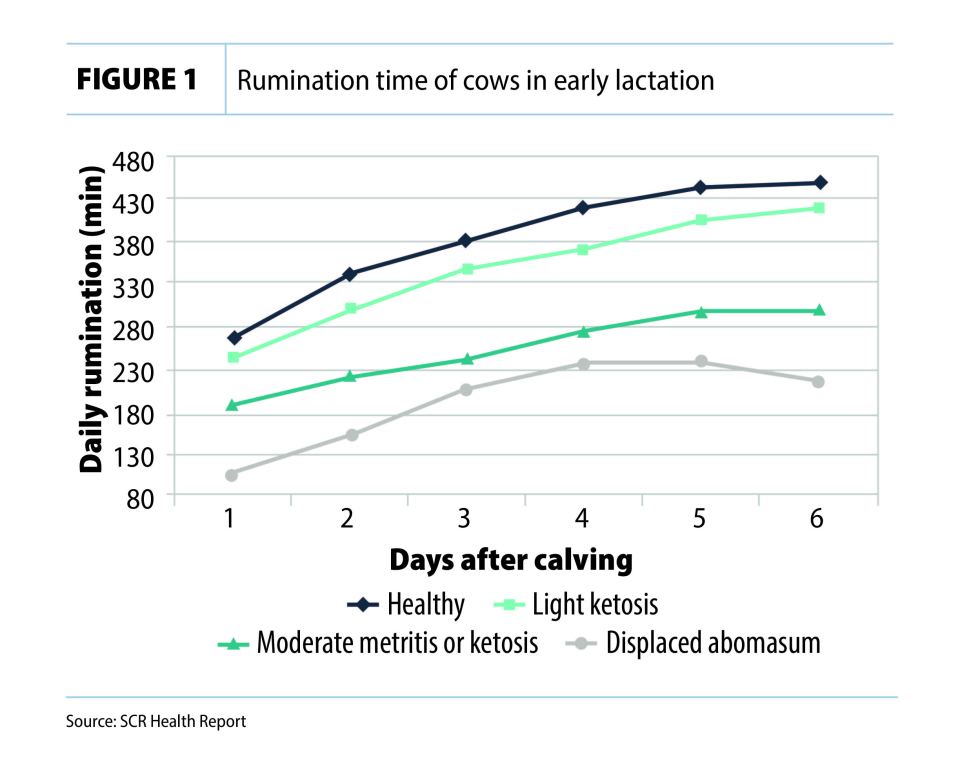Bolster herd health with rumination data
By Haim Fleminger, Key Accounts Manager, Allflex Livestock Monitoring
Early detection and treatment of sick cows helps minimize detrimental effects on milk production, reproduction and overall well-being. Unfortunately, by the time a cow goes off-feed, spikes a fever or shows other disease symptoms, she is already on the path to production loss.
Time spent ruminating is a useful indicator of a dairy cow’s health status. A normal, healthy cow chews her cud between eight and nine hours per day. Reduced cud chewing often signals potential health problems.
Electronic cow monitoring systems from Allflex measure rumination time for individual cows, allowing producers to identify those at-risk of illness and intervene more quickly. Here are five ways producers can use rumination and activity monitoring data to help support herd health and productivity:
1. Diagnose diseases earlier.
Identifying reduction in rumination time with rumination monitoring helps identify sick cows before clinical signs appear. A Cornell University study showed that cows developing ketosis were detected 1.5 days sooner with rumination and activity monitoring.1
With rumination monitoring, producers can respond quickly to adverse situations. If a cow pauses rumination for more than a few hours, she could be suffering from a serious problem, such as milk fever. An alert from the Allflex monitoring system allows for immediate action.
2. Respond to fresh-cow problems.
A cow’s health status after calving impacts her well-being and productivity for the entire lactation. Figure 1 shows the daily rumination time of fresh cows for the first six days after calving. The black line shows healthy cows, which recorded longer rumination times than cows later diagnosed with ketosis or displaced abomasum. This information, which is visible and actionable through the monitoring system, allows the producer to concentrate fresh-pen management on potential problem cows.

3. Refine treatment protocols.
Using cow monitoring, producers may work with their veterinarians to evaluate treatment protocols and potentially select lower cost or less invasive options based on rumination data. For example, if a cow is exhibiting metritis symptoms but is still ruminating normally, she may clear symptoms on her own with supportive therapy.
4. Evaluate treatment response.
Rumination data can immediately gauge a cow’s response to treatment. As she begins to recover, cud chewing should return to normal levels within 10 to 12 hours – usually before milk production improves. If rumination remains low or trends lower after treatment, you might consider an alternate course of action.
5. Reduce cow handling and labor.
By monitoring cows electronically, producers can avoid handling cows that do not need attention. Leaving healthy cows undisturbed allows them more time to eat, lie, down, chew their cuds and exhibit normal cow behavior. Rumination monitoring also eliminates the labor required to take daily fresh cow temperatures.
Allflex Livestock Intelligence cow monitoring systems offer valuable information to support effective and economical treatments and overall cow health outcomes. For more information, view this video or visit the Allflex Livestock Intelligence website.
References:
- Stangaferro, ML, Wijma, R, Caixeta, LS, Al-Abri, MA, Giordano, JO. Use of rumination and activity monitoring for the identification of dairy cows with health disorders: Part I. Metabolic and digestive disorders. J. Dairy Sci. 2016;99(9):7395-7410.
